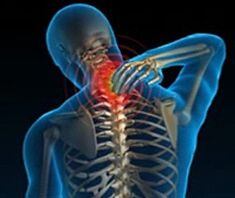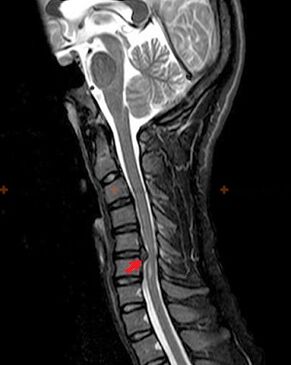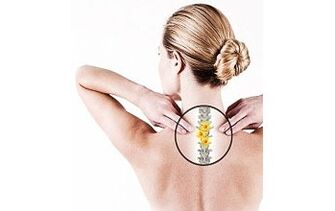Cervical osteochondrosis (cervical osteochondrosis) is a chronic degenerative disease of the spine, in which the structure of the vertebrae is disturbed, the integrity of the intervertebral structures is disturbed, and the roots of the spinal cord are damaged.

It's important to know!Osteochondrosis is not a death sentence.There is always an opportunity to alleviate the exacerbation of the process, as well as to control the progression of changes in the spine.In the most advanced cases, neurosurgical operations are possible.However, this does not negate the fact that the disease can be "unlocked".It is very important to consult a doctor when the first symptoms of osteochondrosis appear in order to diagnose the disease and prescribe early preventive measures!
Reasons for development
The anatomical structure of the spine suggests the greatest mobility in the cervical vertebrae, namely in the cervical vertebrae the vertebrae are the smallest.These two factors make the neck one of the "weak points" of the spine.
The main reasons for the development of osteochondrosis of the cervical vertebrae are a combination of the following adverse factors:
- Improper posture and neck position (including when working with a computer).
- High physical loads on the cervical vertebrae and shoulder girdle.
- Spinal injuries...
- Age-related changes in the tissues of the intervertebral structures.
- Improper diet, low content of essential vitamins and minerals.
It must be said that almost every person develops osteochondrosis with age;according to some researchers, it is "a kind of payback for walking upright."But in the modern world, with its fast life, sedentary lifestyle and prolonged work in front of the computer, cervical osteochondrosis is in the first place among spinal problems.
Symptoms
Symptoms can vary widely depending on the degree of damage to the spine, the severity of degenerative changes, individual characteristics of the human body and many other factors.Neurologists prefer to distinguish three main complexes of symptoms that appear in cervical osteochondrosis, as well as their combination:
- Vertebrogenic cervicalgia.
- Vertebrogenic cervicocranialgia.
- Vertebrogenic cervicobrachialgia.
Based on the names, we can identify the main symptoms of cervical osteochondrosis.So, with cervicalgia, the main complaint will be pain directly in the neck;with vertebrogenic cervicocranialgia, pain in the neck spreads to the head;with cervicobrachialgia, neck pain spreads to one or both arms, arm cramps also develop, numbness and a crawling sensation in the arms may occur.In all cases of osteochondrosis, the following symptoms may appear: tension in the neck muscles, neck crunch, restriction of neck movements.
Radiculopathy
In the presence of severe osteochondrosis, complicated by the presence of protrusions or disc herniations, the so-called radiculopathy can form: a malfunction of a certain spinal root with the development of weakness of the innervated muscles, weight loss and sensitivity disorders.
Diagnosis and X-ray signs
Osteochondrosis is an X-ray diagnosis, since a detailed clinical picture is available only at the time of exacerbation, while changes in the spine can occur with complete subjective well-being of a person.Without an X-ray examination, we can only talk about suspicion of osteochondrosis, since similar symptoms can be caused by other diseases (myositis, vertebral neoplasms and others).

The following research methods are used to diagnose osteochondrosis: radiography (preferably with functional tests), MSCT and MRI.The latter study is the most preferred due to the fact that it allows to visualize very clearly the state of the intervertebral structures.
X-ray signs of osteochondrosis include the following changes in the spine:
- Decreased height of the intervertebral discs.
- Presence of marginal bone growths.
- Violation of the location of the vertebrae relative to each other.
- Deformations of the vertebral bodies and arches, etc.
The presence of the changes described above, as well as the changes in the structure of the intervertebral disc detected by MSCT and MRI, serve as reliable signs confirming the presence of osteochondrosis.
Treatment
Treatment should be comprehensive and aimed at all aspects of the pathogenesis of the clinical manifestations.Chronic dystrophic changes during exacerbations lead to inflammation of the roots of the spinal cord, which in turn reflexively causes pain.Pain is a signal for the muscles to develop a protective reaction - muscle spasm.Muscle spasm brings the vertebrae together and increases compression (compression) and inflammation of the roots.The circle is closed.Therefore, it is necessary to eliminate inflammation, pain and muscle spasms and to protect the roots from inflammatory effects.

There are drug and non-drug treatment methods.They change partially in the presence of certain predominant symptoms, but have a general pattern.
medicines
Anti-inflammatory agents (aceclofenac, ketoprofen, meloxicam, diclofenac, etc.), muscle relaxants (tolperisone hydrochloride, baclofen, tizanidine), neuroprotective drugs (complex preparations of B vitamins and thioctic acid) are used.
Non-medicinal
Includes massage, physiotherapy and physical therapy.Massage for cervical osteochondrosis very effectively relieves muscle spasm, improves blood flow to the tissues of the spine, which reduces the severity of the inflammatory process.Physiotherapy can be aimed both at relieving pain (electrophoresis with analgesics) and at relieving muscle tension (diadynamic currents).Physical therapy is a unique and extremely effective method of disease prevention.You can see a set of exercises for cervical osteochondrosis therapy here.
People's funds
Among the traditional methods of treatment, we must highlight the use of various warming compresses based on water and alcohol, which can reduce the intensity of neck pain and reduce inflammation.The "dry heat" method has also proven itself well, the essence of which is to heat salt or sand placed in a cloth bag and then apply it to the site of pain.
Some of the traditional methods of treating osteochondrosis of the cervical spine include the use of applicators - special devices or simply needle-like surfaces of tissues.Applying moderate pressure to the neck area, as well as simply lying on such a surface for 10-15 minutes, causes reflexive relaxation of the cervical muscles and relief of distracting pain.






















